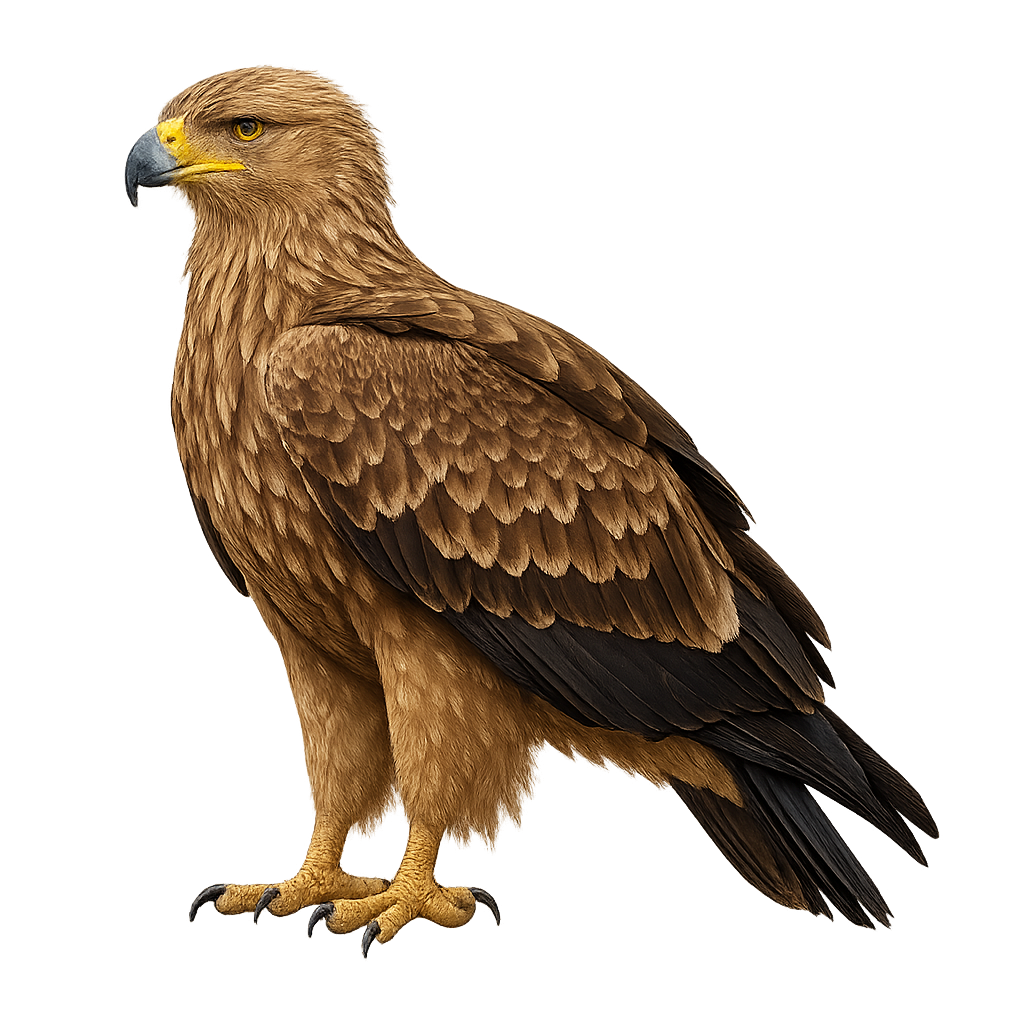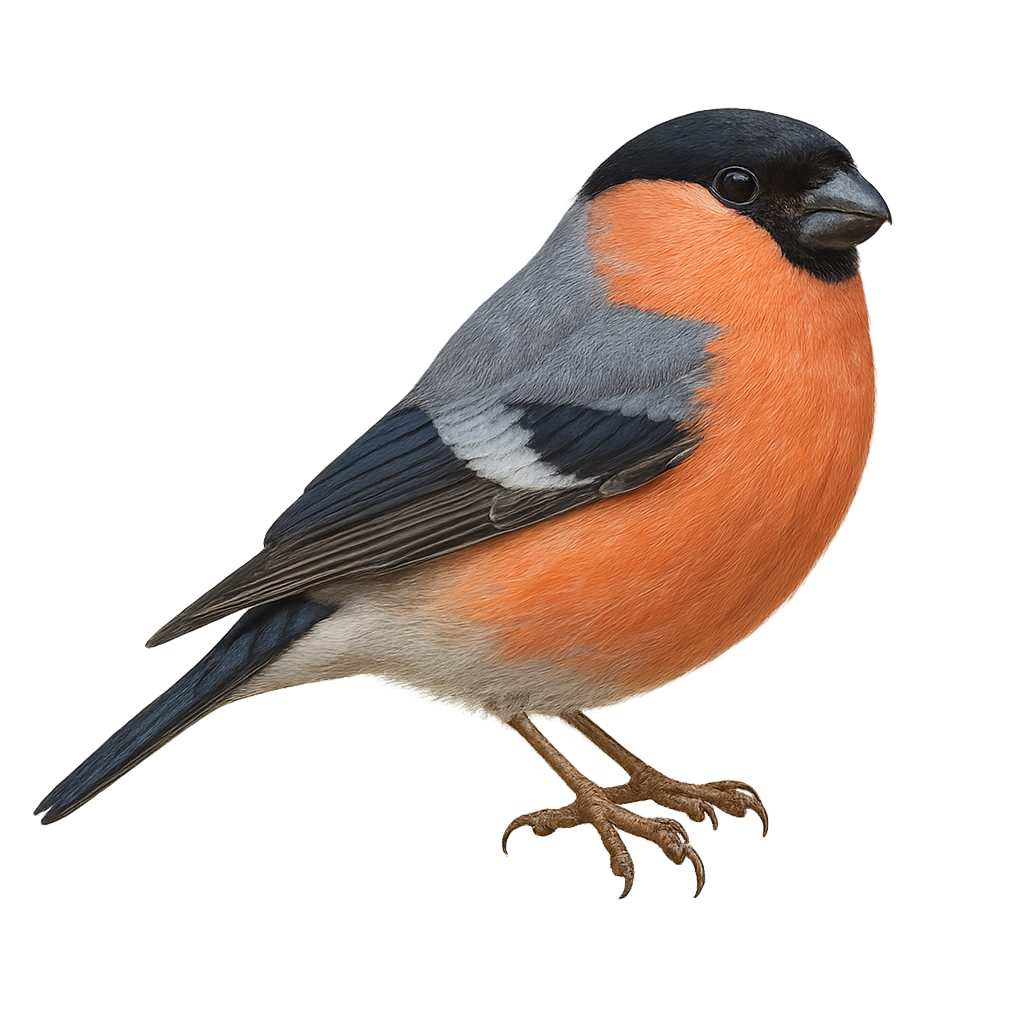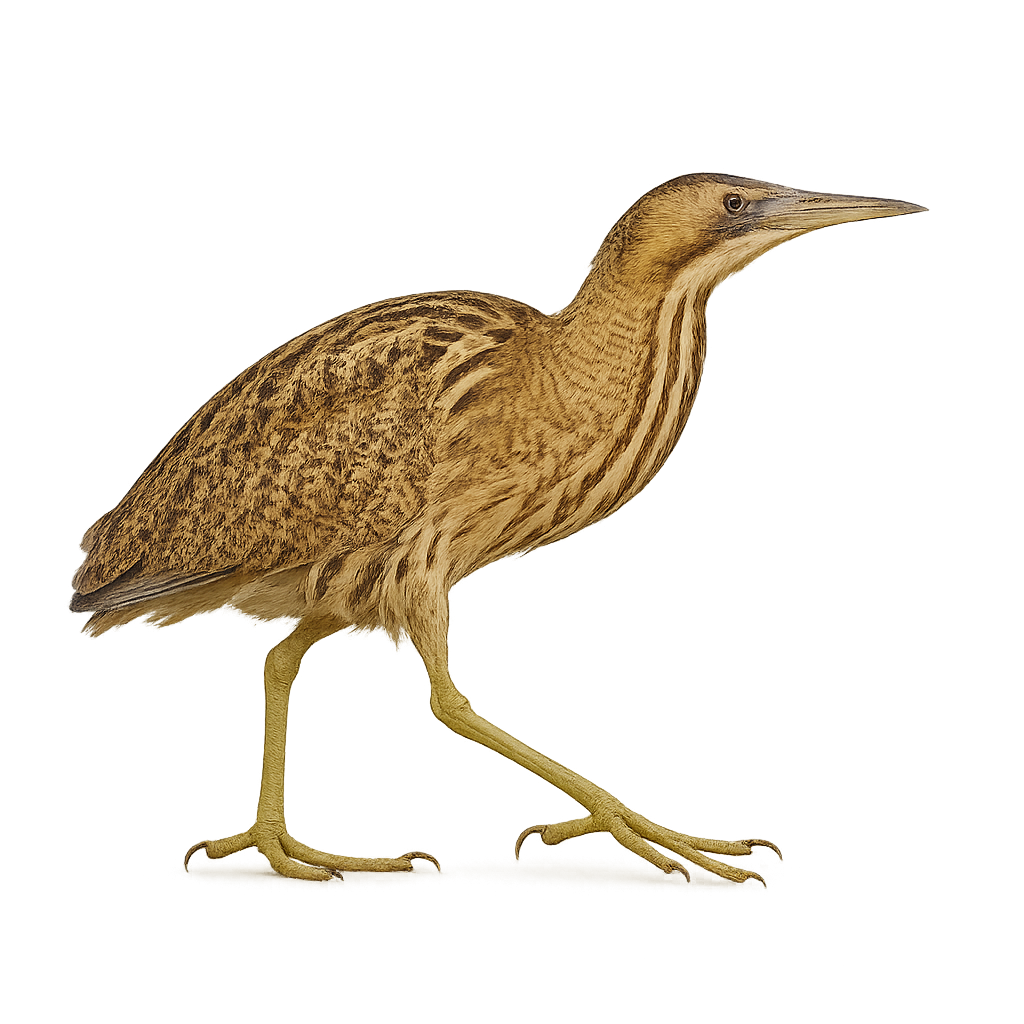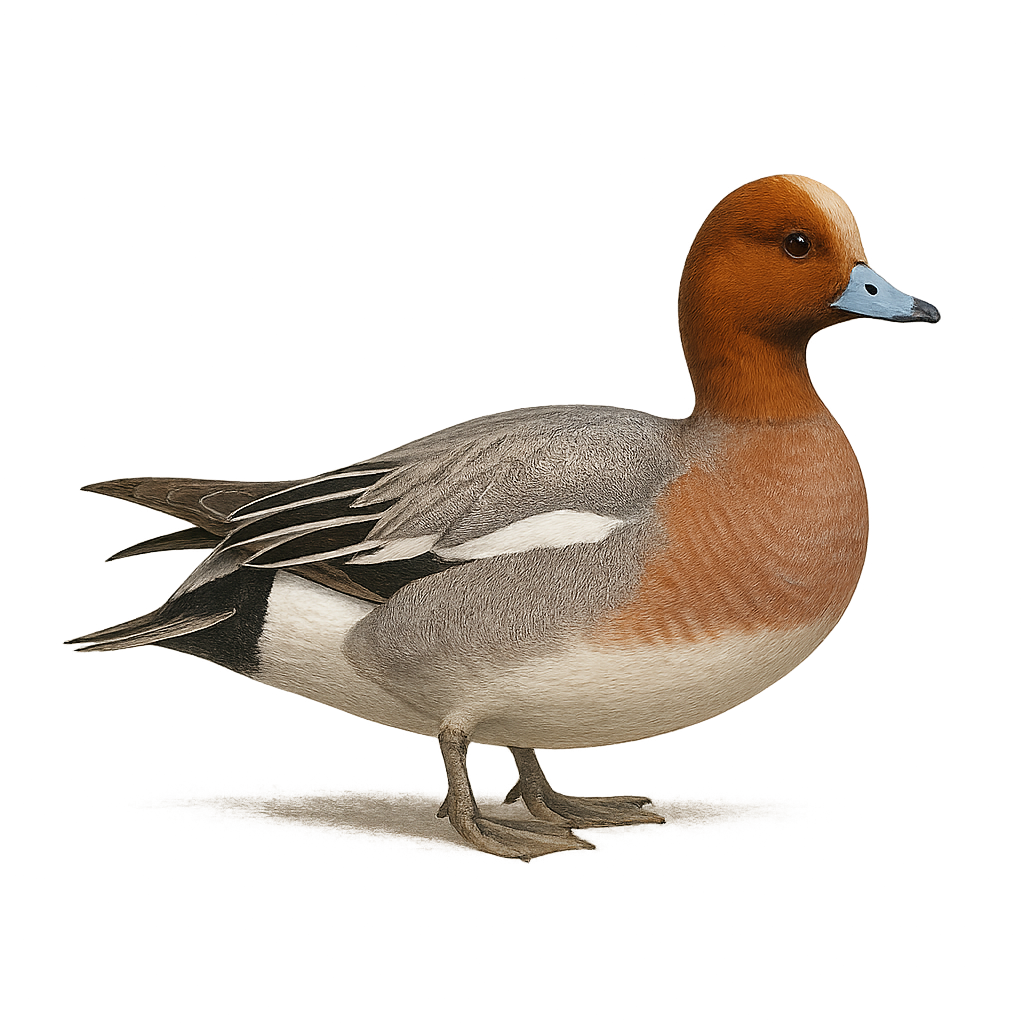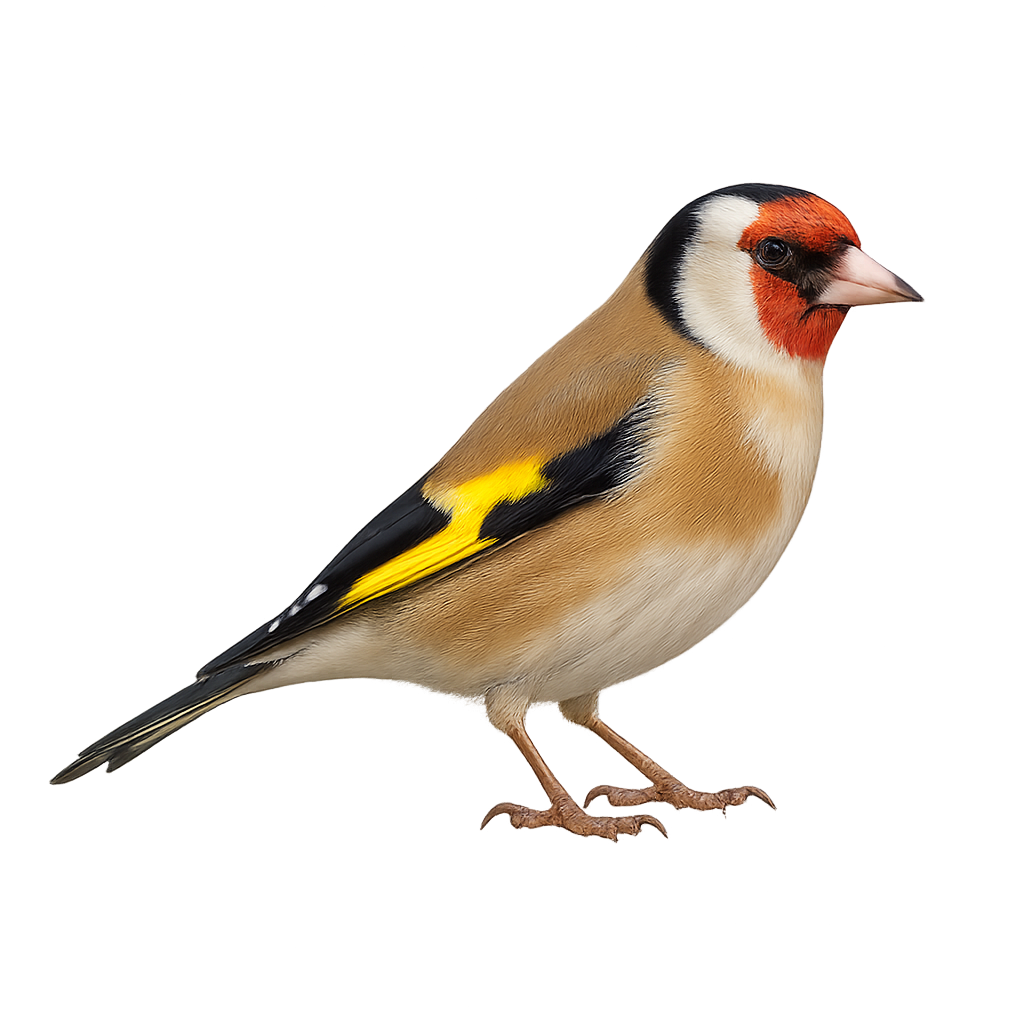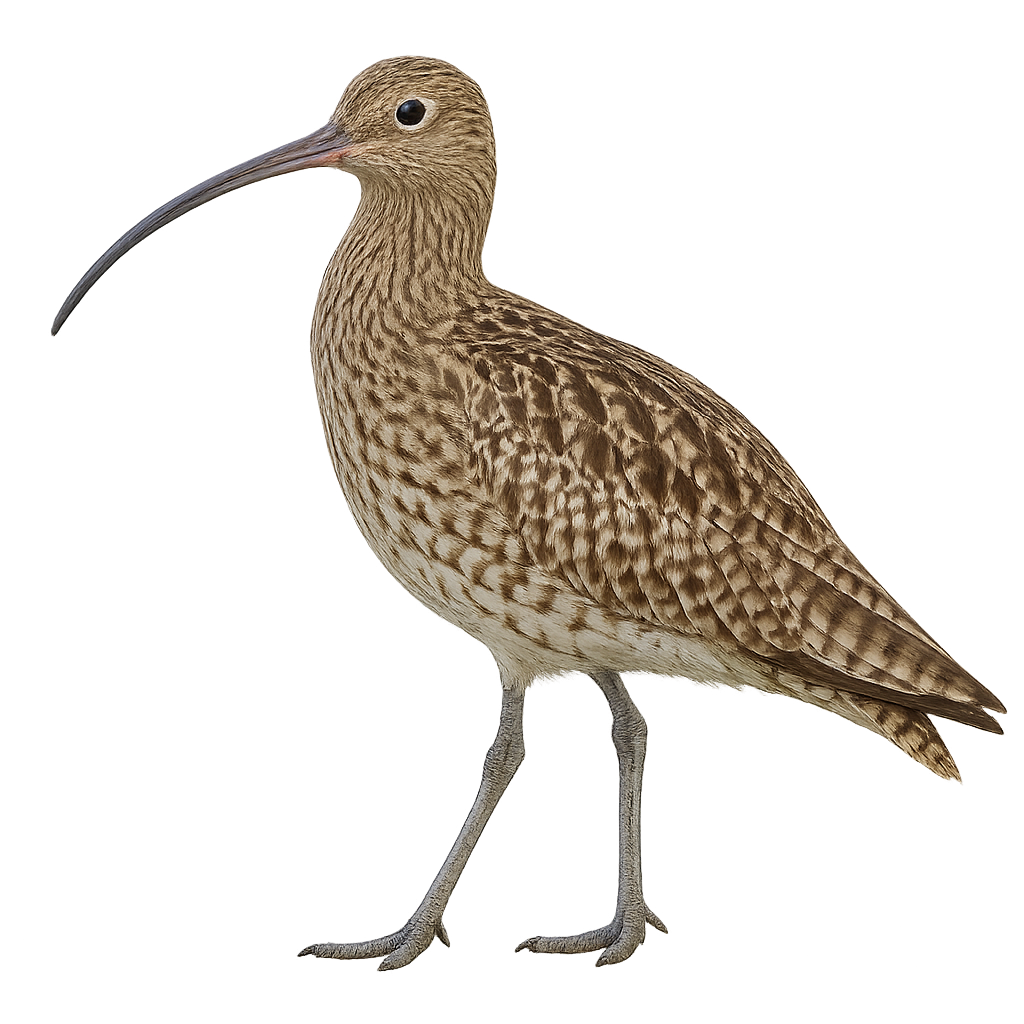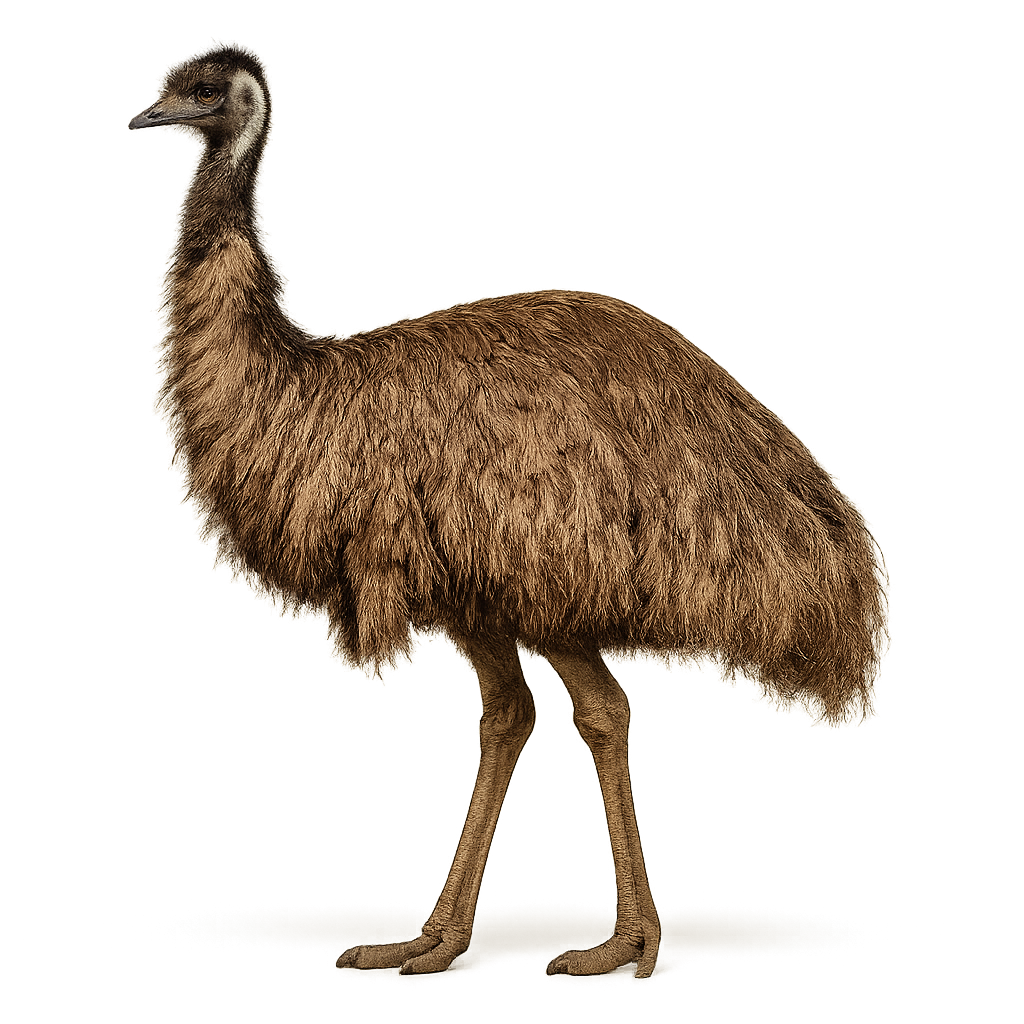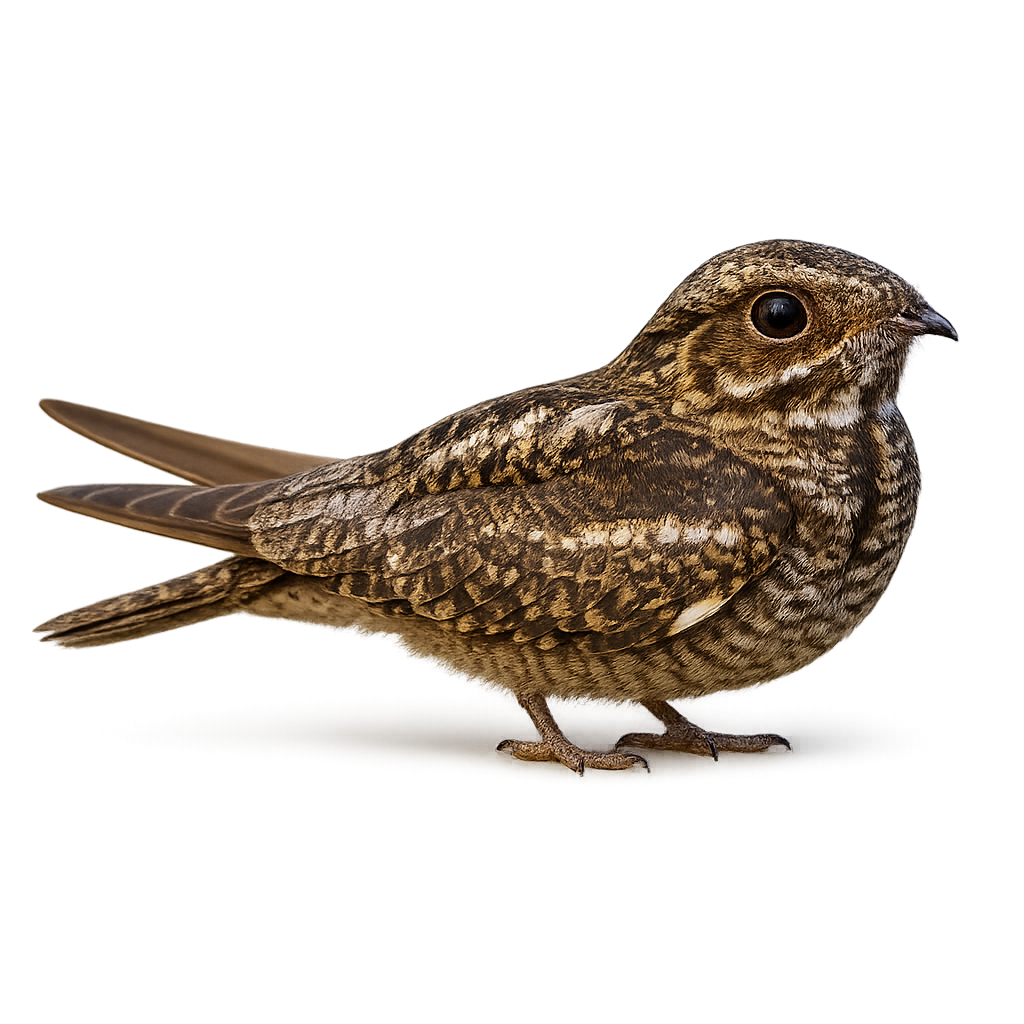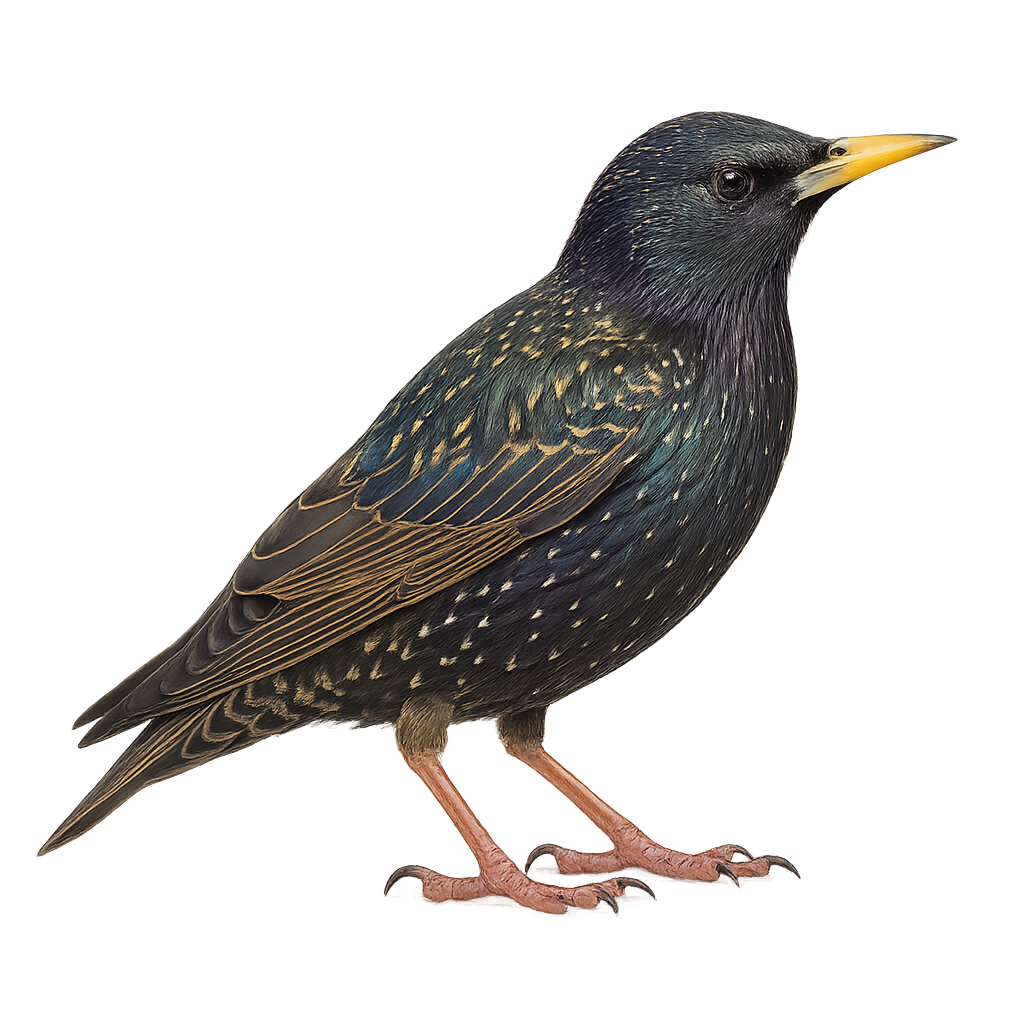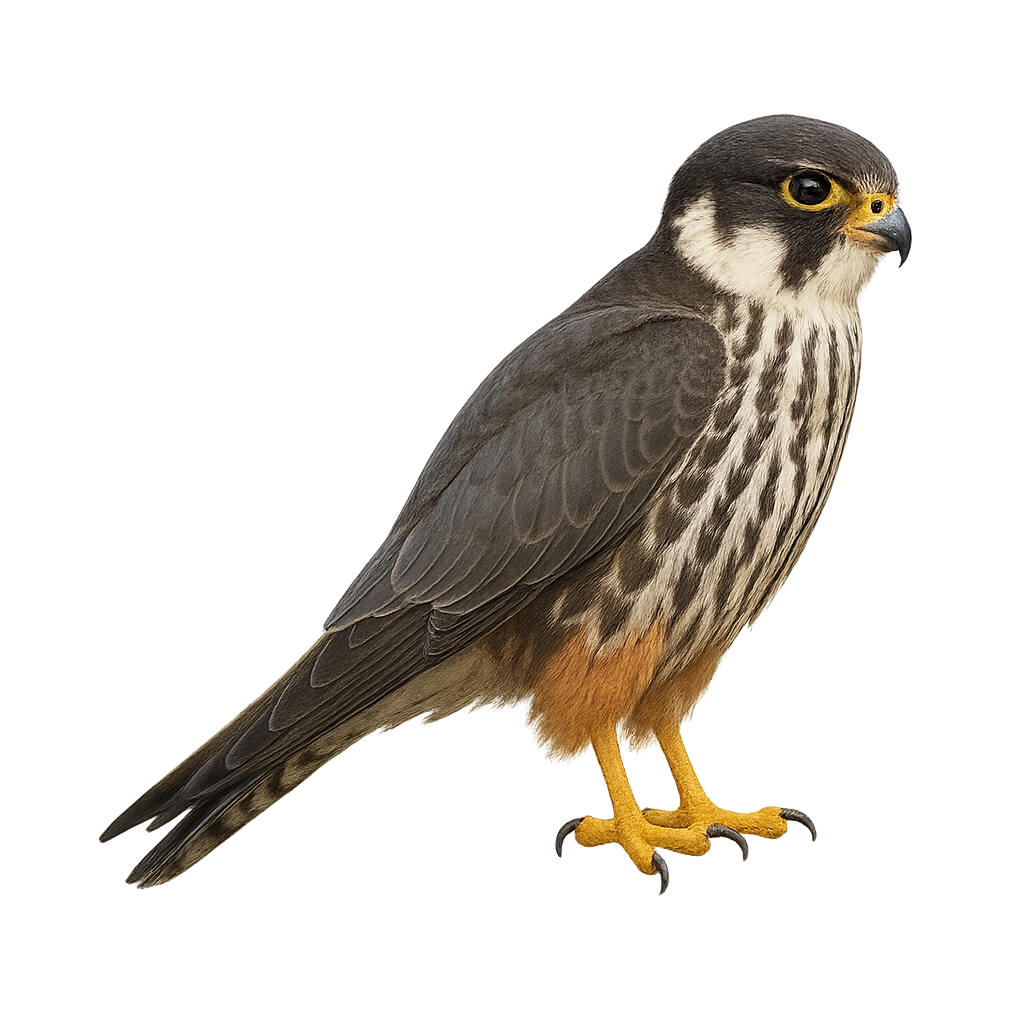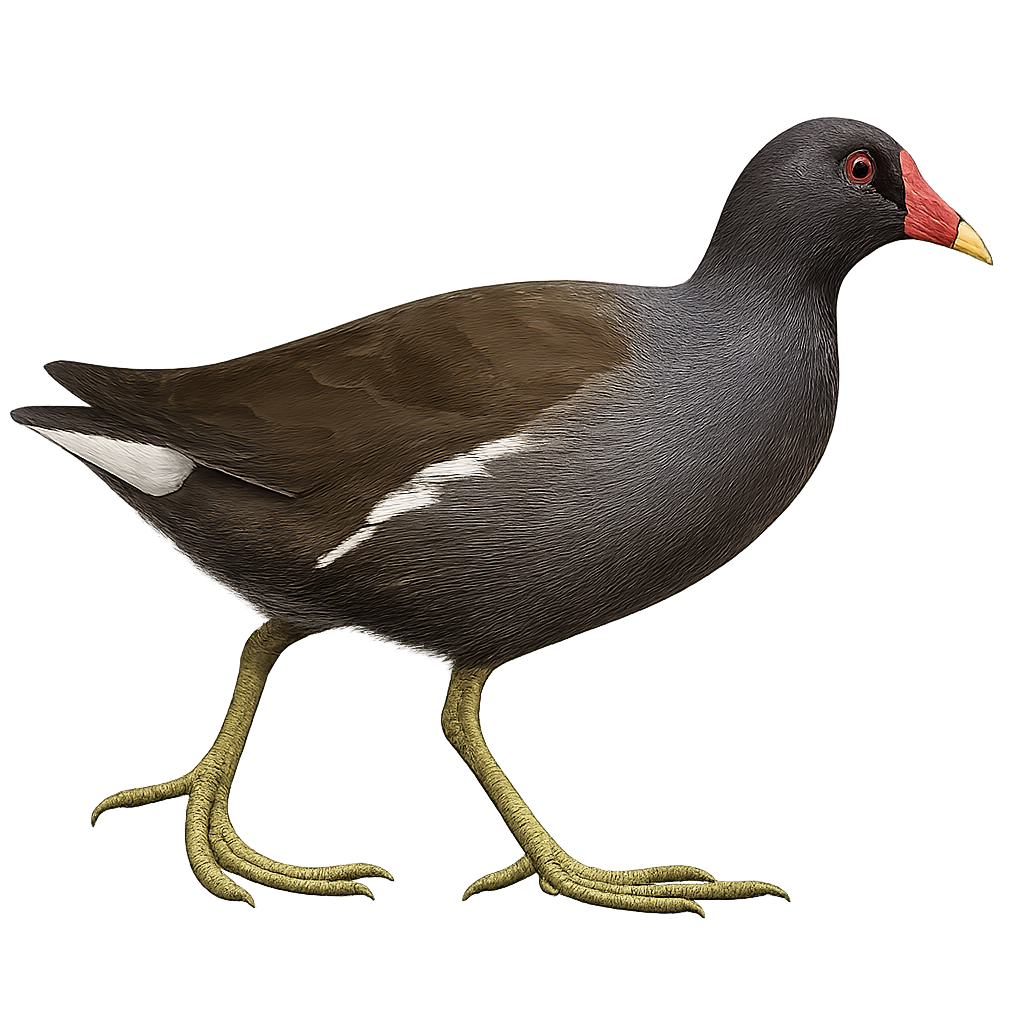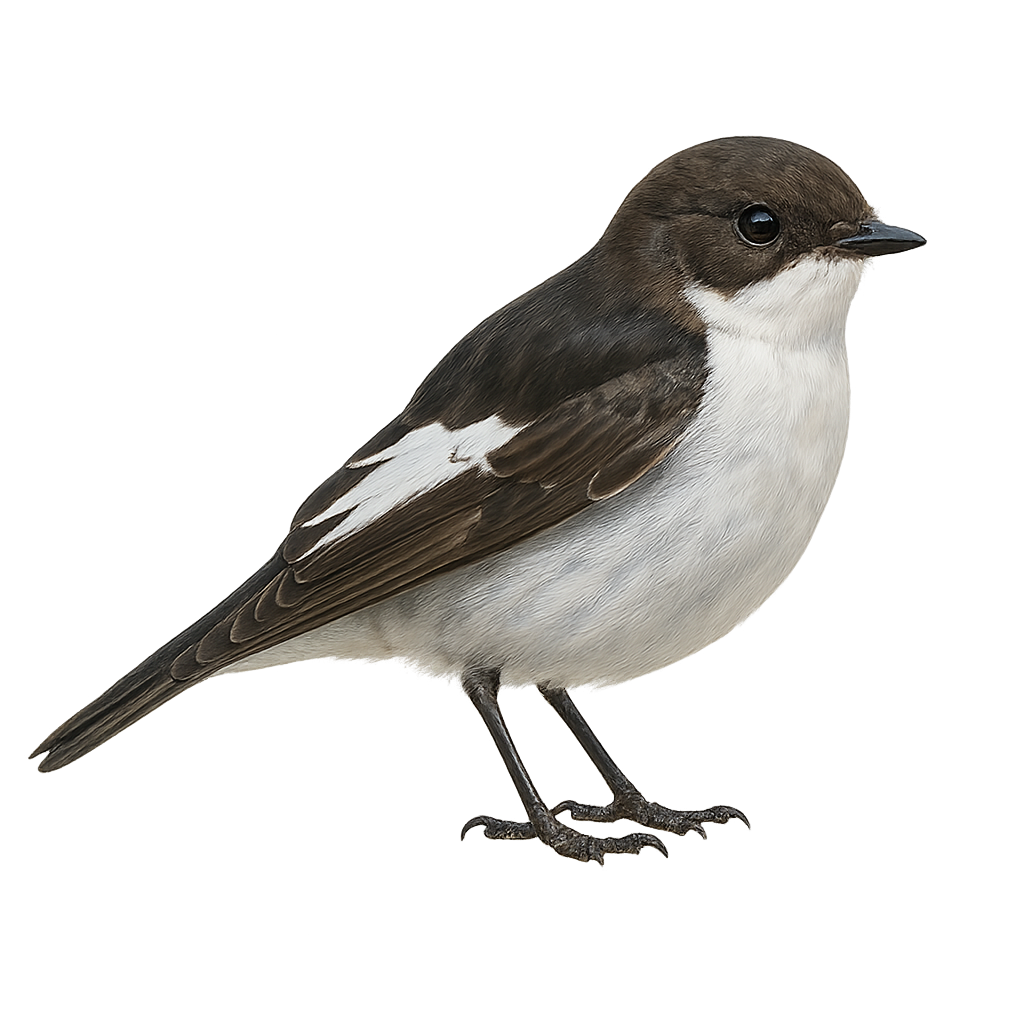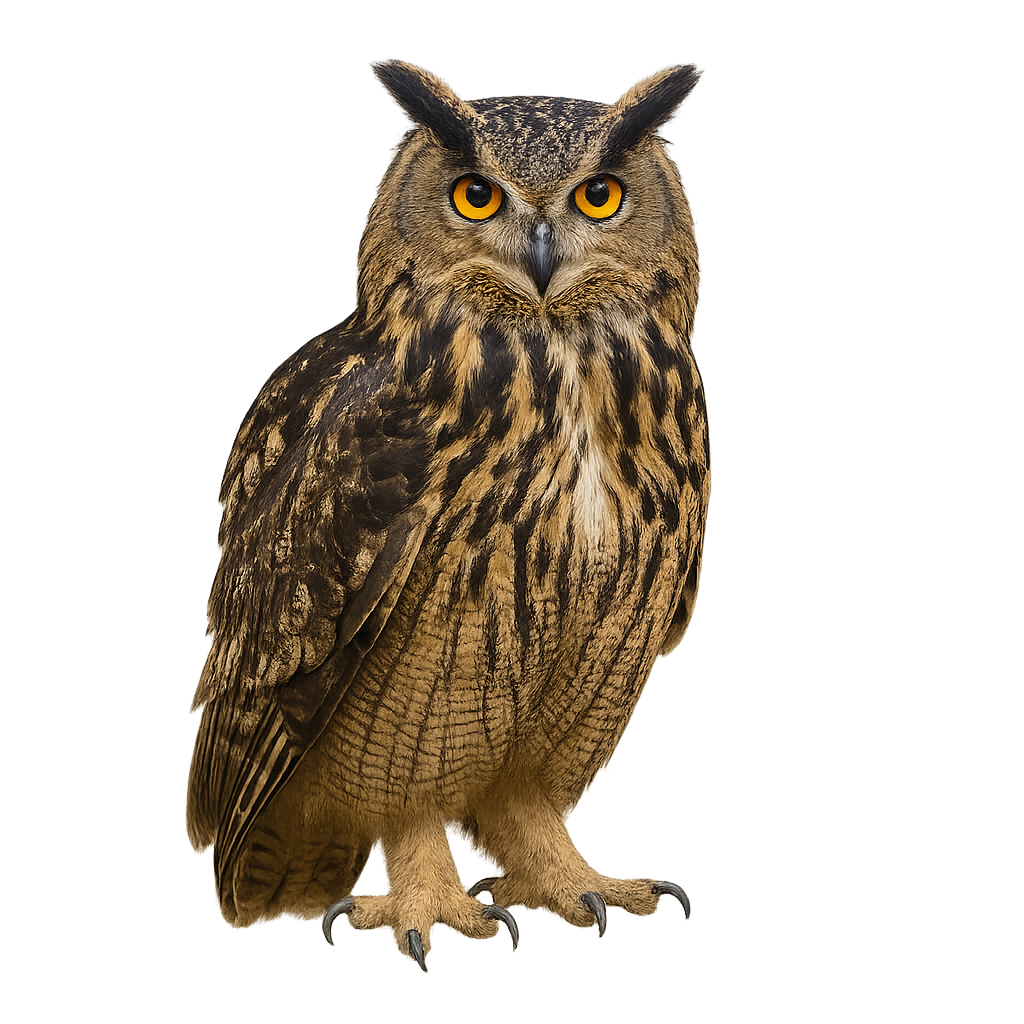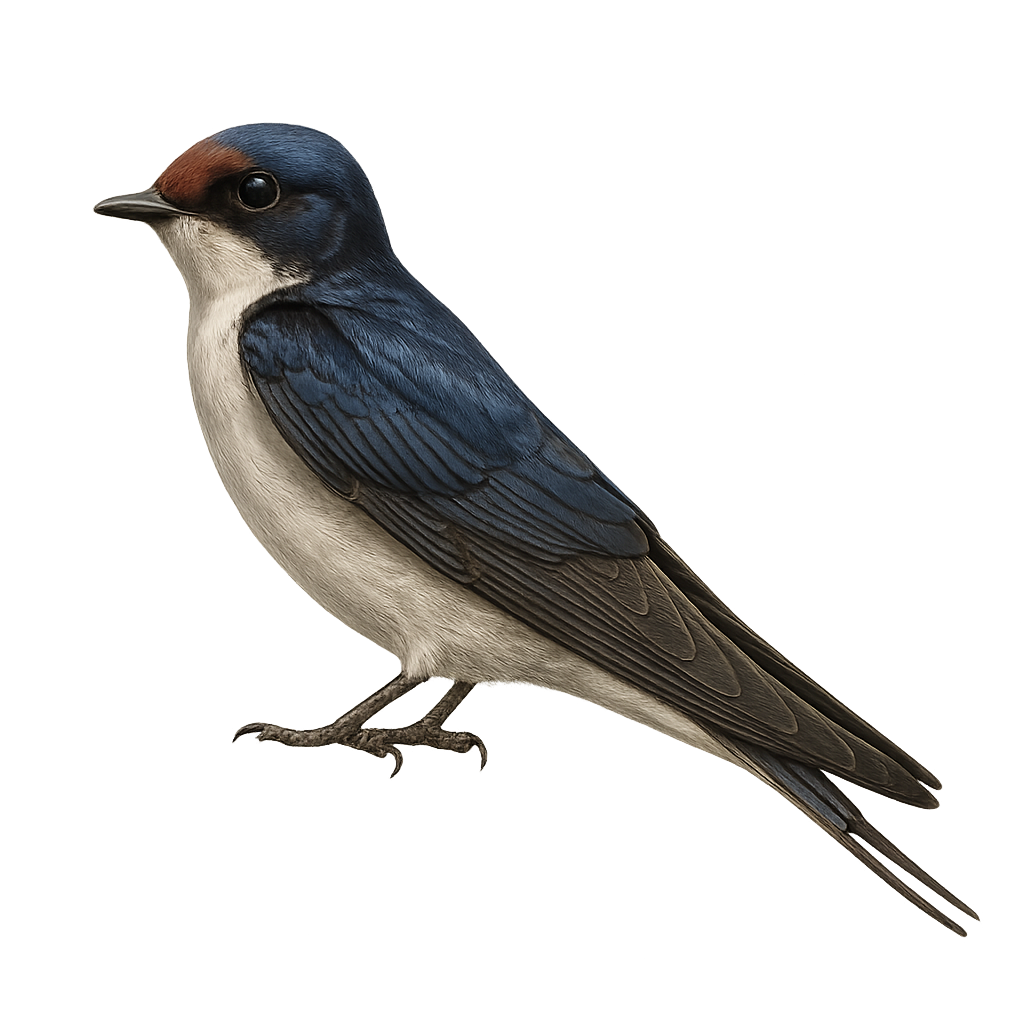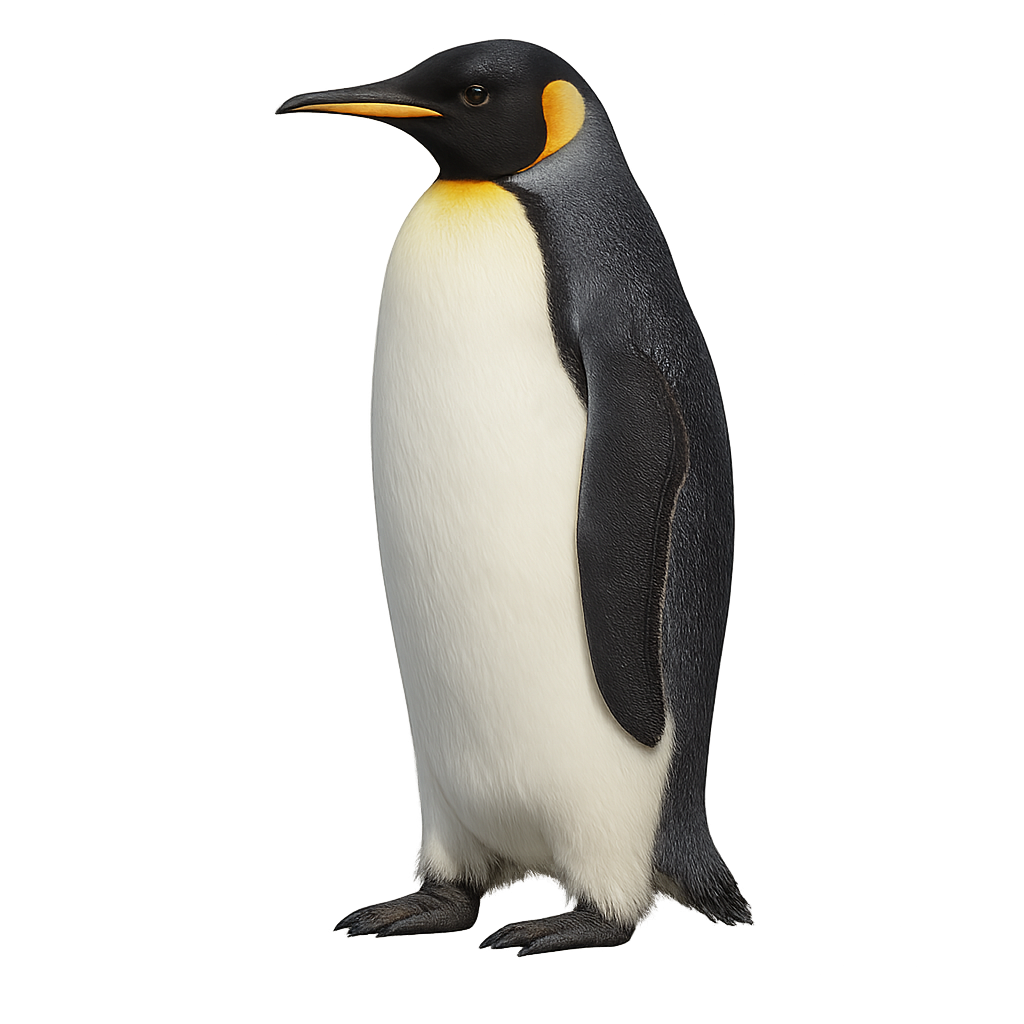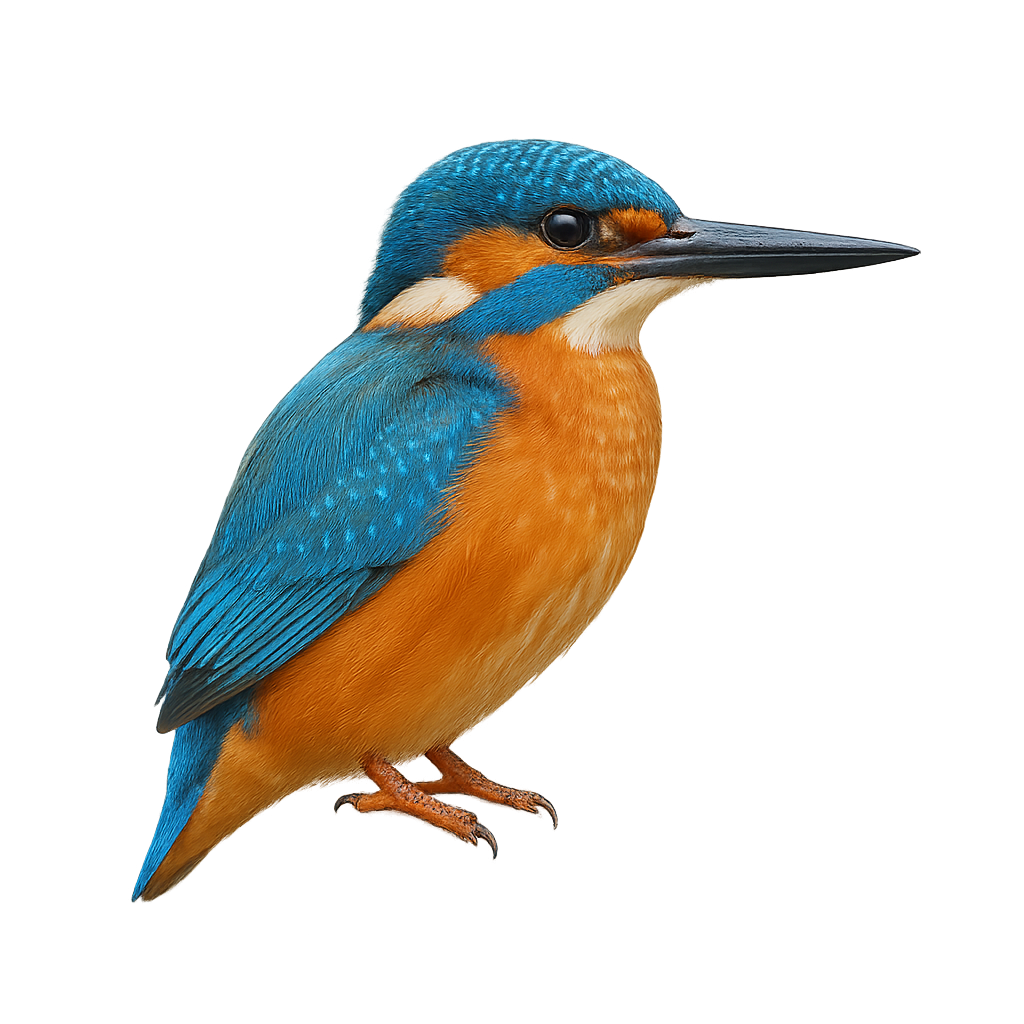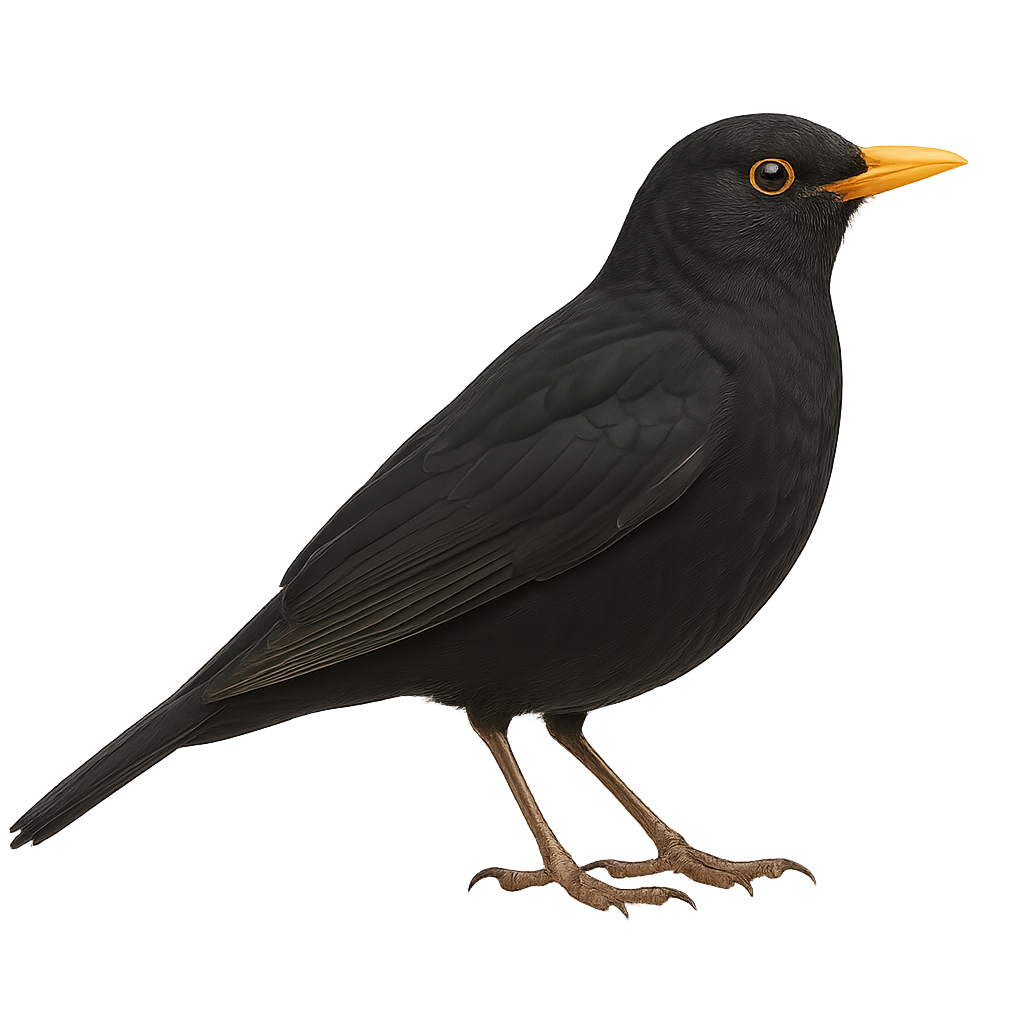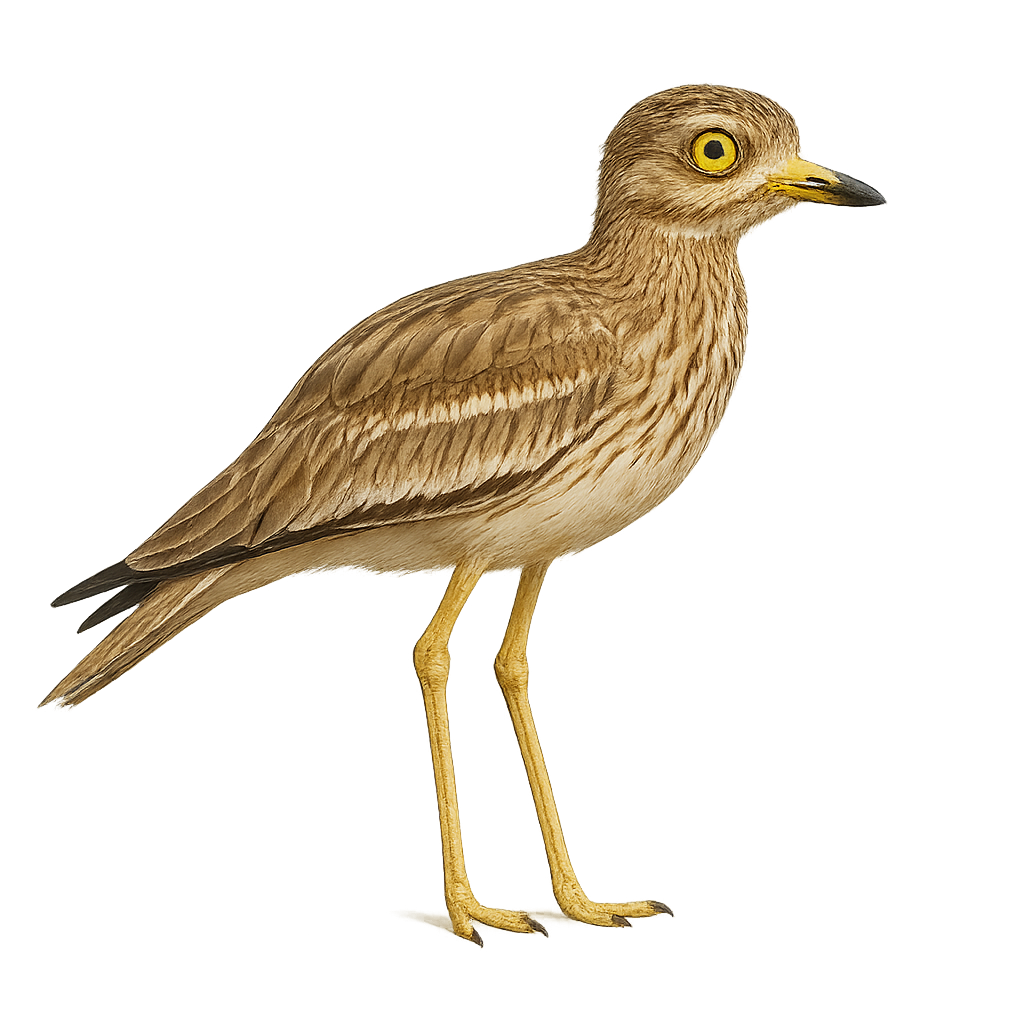The Eastern imperial eagle is a large raptor measuring 68–90 cm in body length and spanning 1.76–2.2 m, with dark brown plumage, a pale golden head and contrasting white shoulder patches. It inhabits mature forest edges, wooded mosaics and open steppes across southeastern Europe and Central Asia, hunting primarily small mammals, birds and reptiles by stoop or soaring flight.
The Eurasian skylark is a small passerine of 15–17 cm with streaked brown plumage and pale underparts. It inhabits grasslands, cultivated fields and fallow land, feeding on seeds and insects on the ground or in flight. During the breeding season, males perform hovering song flights to attract females and defend territory.
The Eurasian bullfinch is a small, stocky passerine (14–16 cm) with bright pink-and-black plumage in males and more subdued tones in females. It inhabits mixed woodlands, hedgerows, and orchards across Europe and Asia, feeding on seeds and buds in winter and insects in spring. During the breeding season (April to July), the male utters soft calls from a perch and both partners build a sturdy nest of twigs and moss.
The Great Bittern is a large, secretive heron, easily recognized by its brown spotted and striped plumage, which allows it to blend perfectly into the reeds and vegetation of wetland areas where it lives. This nocturnal and solitary bird primarily inhabits marshes, ponds, and reed beds in Europe, Asia, and North Africa. It feeds mainly on fish, amphibians, and small birds, which it hunts by silently creeping through aquatic plants or standing still to wait for its prey.
The Great Bittern is an excellent master of camouflage, using its plumage to conceal itself in its environment, making it difficult to observe. Migratory, it leaves its breeding grounds to travel to Africa during the winter. While it is listed as "Near Threatened" on the IUCN Red List, it remains vulnerable to habitat loss due to wetland drainage and urbanization.
The Eurasian Wigeon is an elegant waterfowl, easily recognizable by its distinctive plumage and characteristic whistle. The male, during the breeding season, has colorful plumage with a dark green head, light brown body, and a white stripe running across its neck. The female is more subdued, with speckled brown plumage, adapted for camouflage. This duck gets its name from the whistling sound it makes during its movements and social interactions.
The Eurasian Wigeon primarily inhabits wetlands, such as lakes, ponds, and marshes, where it feeds on aquatic plants, seeds, and insects. It is a long-distance migratory bird, leaving its breeding grounds in Europe to travel to warmer regions in Africa or the Middle East during the winter. While its population remains generally stable, it faces threats related to habitat loss and water pollution.
The European goldfinch is a small, colorful bird found mainly in gardens, hedgerows, and meadows across Europe and Asia. It is easily recognized by its bright yellow plumage, black and white wings, and distinctive red head. This finch primarily feeds on thistle seeds, wildflowers, and insects. It is also known for its melodious song and its ability to adapt to various types of habitats.
The Eurasian Pygmy Owl is the smallest owl in Europe, easily recognized by its tiny size and large, piercing yellow eyes. It has gray-brown plumage, with white markings on the chest and abdomen, and dark spots on its head. It has a stocky body and a small, round head, without the ear tufts found in other owls. This nocturnal predator primarily inhabits coniferous forests, where it hides in tree cavities or old nests to rest during the day.
The Eurasian Pygmy Owl primarily hunts small birds, insects, and rodents, which it captures at dawn or dusk. While its population remains relatively stable in some regions of Northern and Eastern Europe, it is threatened by deforestation and disruption of its habitats. This owl is protected by conservation measures aimed at preserving its coniferous forests and nesting sites.
The Macaroni Cormorant is a large aquatic bird, easily recognized by its slender silhouette, glossy black plumage, and the tuft of feathers on top of its head, which gives it its name. It has a long, pointed beak, perfectly adapted to catching fish, which it captures by diving underwater. Macaroni cormorants are often seen on rocky coastlines, islands, or along marine shores, where they form large breeding colonies.
This cormorant primarily feeds on fish, but also consumes crustaceans and mollusks. It is an exceptional diver, capable of diving to considerable depths to hunt its prey. Although its population remains relatively stable, it is threatened in certain regions by habitat disruption, water pollution, and competition with other fishing birds. It is mainly found in the Mediterranean and along certain Atlantic coasts of Europe.
The Eurasian Curlew is a large wader, easily recognizable by its long, down-curved bill and gray-brown plumage with dark speckling. This wader has a slender silhouette, long legs, and broad wings. It measures about 50 to 60 cm in length, with a wingspan of 90 to 105 cm. During the breeding season, the Eurasian Curlew has brighter and more contrasting plumage, but it becomes more subdued during winter, with duller tones.
The Eurasian Curlew primarily feeds on earthworms, invertebrates, and small crustaceans, which it captures in marshy areas, wet meadows, or along riverbanks. It is mainly observed in coastal areas or estuaries, where it forages by probing the ground for food. Although it is migratory, the Eurasian Curlew breeds mainly in Europe and winters in North Africa and southern Europe. It is currently classified as vulnerable due to habitat loss and disturbances in its breeding areas.
Emu
Dromaius novaehollandiae
The Emu is a large flightless bird, belonging to the ratite family, which also includes the ostrich and the kiwi. It typically stands between 1.5 and 1.9 meters tall and weighs between 40 and 60 kg. Its plumage is generally brown-gray, with fine feathers that give it a slightly ruffled appearance. The Emu is recognizable by its long bare neck and small wings, which prevent it from flying. It is endemic to Australia, where it inhabits a variety of environments, from open forests to savannas and semi-desert areas. This bird is primarily herbivorous, feeding on seeds, fruits, roots, and young shoots. Although it cannot fly, the Emu is a fast runner, capable of reaching speeds up to 50 km/h over short distances. It is often solitary or lives in small groups, except during the breeding season. The Emu plays an important role in seed dispersal, contributing to the regeneration of vegetation. While the species is currently listed as of least concern, it faces threats such as habitat loss, hunting, and collisions with vehicles.
The European Nightjar is a nocturnal bird, often difficult to spot due to its perfectly camouflaged plumage that helps it blend into its surroundings. It measures about 23 to 26 cm in length, with a wingspan of 50 to 55 cm. Its plumage is primarily brown, with complex patterns of spots and streaks that perfectly mimic the colors and textures of forest floors or dry meadows. The European Nightjar primarily feeds on nocturnal insects, which it captures in flight with its wide mouth open. It hunts at dusk and during the night, using its broad, rounded wings to maneuver silently through the air. This bird is often seen flying in circles or zigzags above fields, forests, or open areas. During the breeding season, the female lays its eggs directly on the ground, often in well-hidden spots. While the species is not currently endangered, it faces threats such as habitat loss, light pollution, and the decline of nocturnal insects.
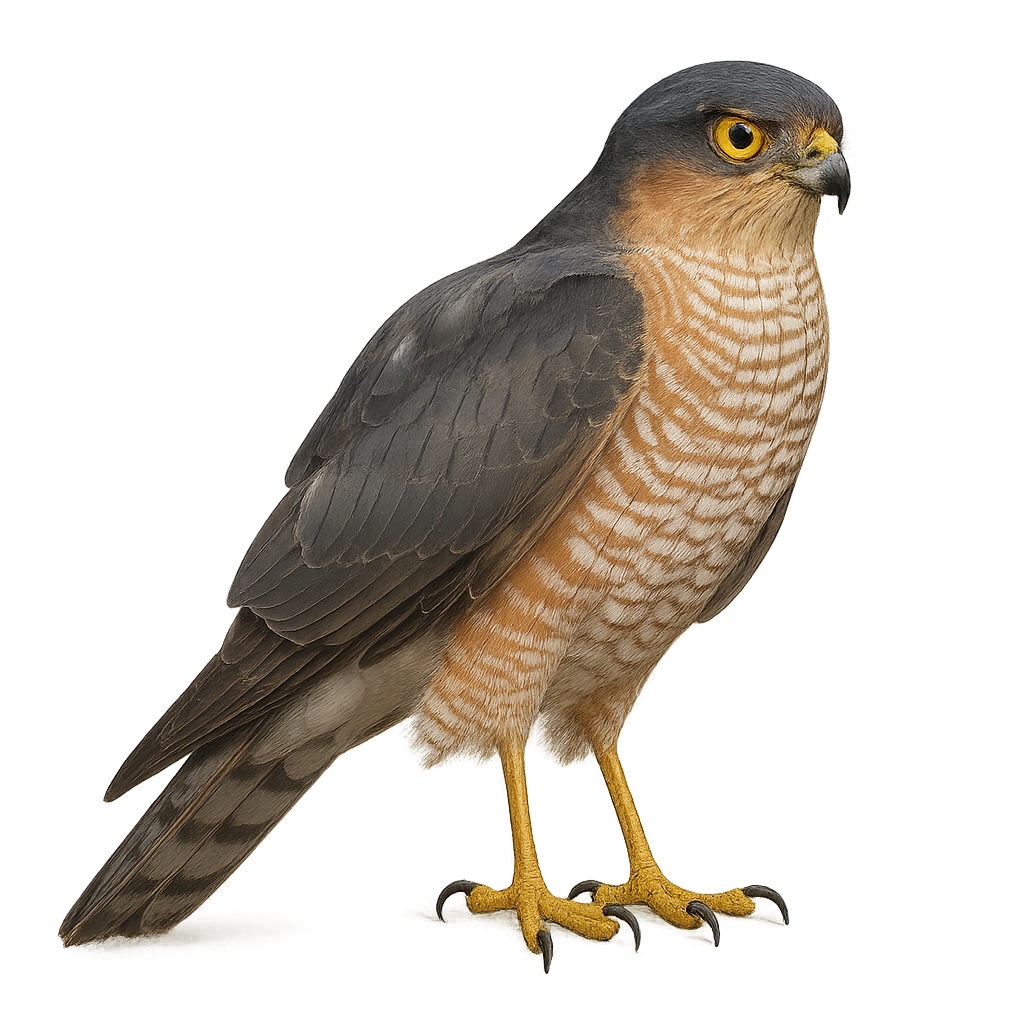
The European Sparrowhawk is a small raptor from the Accipitridae family, easily recognizable by its gray-brown plumage and narrow wings adapted for hunting in forests. It measures about 30 to 40 cm in length, with a wingspan of 60 to 90 cm, and weighs between 150 and 250 g. The male is generally smaller than the female. Its plumage varies depending on sex and age, but adults have bluish-gray feathers on the back and brownish horizontal bars on the belly. The European Sparrowhawk primarily inhabits dense forests and wooded areas in Europe, but it can also be found in urban parks and gardens. This raptor is an excellent hunter, primarily feeding on smaller birds, which it captures in flight after a rapid pursuit through trees. It often hunts using a silent, swift flight technique and is capable of capturing prey in confined spaces. Although the European Sparrowhawk is currently listed as of least concern, it faces threats such as habitat loss, disturbance of its nesting sites, and persecution by humans.
The European starling is a very social bird found across Europe, Asia, and North America. It is easily recognized by its iridescent plumage, which changes color depending on the light. This bird is highly adaptable, living in both urban and rural environments. The European starling is also an excellent imitator, capable of mimicking a variety of sounds, including calls of other birds and human noises. Its ability to form large flocks makes it an ideal subject for group photography.
The Hobby Falcon is a small diurnal raptor, often confused with other falcons due to its similar size, but it is distinguished by its elegant plumage and unique characteristics. It measures about 30 to 40 cm in length, with a wingspan of 70 to 90 cm, and weighs between 150 and 250 g. Its plumage is primarily grayish, with a darker head and back and a lighter belly. Males have a lighter plumage than females, which are generally larger and darker. This falcon primarily inhabits open areas such as meadows, heathlands, and sparse forests, as well as mountains and agricultural zones. It hunts by flying at high speed, capturing small birds, insects, and sometimes small mammals. Its flight is fast and direct, often interrupted by sharp turns and dives to capture its prey. While the species is not endangered, it faces threats such as habitat loss and the reduction of its prey populations.
The Eurasian moorhen is an aquatic bird found mainly in wetlands, marshes, lakes, and rivers across Europe, Asia, and North Africa. It is easily recognized by its dark plumage, bright red and yellow beak, and prominent forehead. This aquatic passerine primarily feeds on aquatic plants, small invertebrates, and insects. The moorhen is also known for its discreet behavior and tendency to hide in dense vegetation.
The pied flycatcher is a small migratory passerine, 11–13 cm long, with striking black-and-white plumage: the male has a glossy black back and head contrasting with a white belly, while the female shows duller brownish tones. It inhabits open woodlands, forest edges, and parks, feeding mainly on insects and spiders caught in flight or gleaned from foliage. During the breeding season, the male performs aerial chases and sings to attract the female and defend his territory.
The Laniarius aethiopicus, or Ethiopian Boubou, is a bird with distinctive plumage, primarily black with a bright red chest. It inhabits wooded regions and savannas of East Africa. Known for its melodious song and vocal duets, it is often heard at dawn and dusk. It primarily feeds on insects but can also consume fruits and small vertebrates. The Ethiopian Boubou is a territorial bird, often seen in pairs or small family groups. Although relatively common in its natural habitat, it can be challenging to spot due to its discreet behavior and dark plumage that blends into the shadows of the vegetation.
The Eurasian Eagle-Owl is a large nocturnal raptor, one of the most imposing owls in the world. It measures between 60 and 70 cm in length, with a wingspan of 1.6 to 1.8 meters, and weighs between 1.5 and 4.5 kg. Its plumage is primarily brown, with white and black mottled patterns, and its eyes are bright orange, giving the bird a piercing gaze. It also has tufts of feathers on its head that resemble ears, which give it a distinctive appearance. The Eurasian Eagle-Owl primarily inhabits forests, mountains, and rocky areas in Europe, Western Asia, and the Middle East. It is an opportunistic hunter, feeding mainly on small mammals, birds, and sometimes reptiles or amphibians. The Eurasian Eagle-Owl is a solitary and territorial bird, known for its powerful and deep calls, often heard at night. While the species is not endangered, it may be affected by the destruction of its natural habitat and human disturbances.
The Eared Grebe is a small grebe measuring between 28 and 35 cm in length with a wingspan of 57 to 59 cm. In breeding plumage, it has a black head adorned with golden feathers forming a crest, a black neck, a black chest, and chestnut flanks. In non-breeding plumage, it is more subdued, with a black back, black cap, white cheeks, and a white belly. It frequents shallow lakes and ponds, rich in aquatic vegetation, where it primarily feeds on small fish and aquatic invertebrates. Reproduction occurs in summer, with a clutch of 3 to 6 eggs laid in a floating nest. The young are capable of swimming shortly after hatching and can be carried on the parents' backs. A migratory species, it winters in the Mediterranean and warmer regions. Listed as Least Concern by the IUCN.
The European Bee-eater is a small, colorful bird, easily recognizable by its vibrant plumage, which features a combination of bright colors, mainly blue, green, yellow, and orange. It measures about 28 to 30 cm in length, with a wingspan of 40 to 45 cm, and weighs between 30 and 40 g. Its beak is long and pointed, perfectly adapted to catching insects in flight, primarily wasps, bees, and other flying insects. The European Bee-eater primarily inhabits open areas, grasslands, forest edges, and steppes in Europe, as well as North Africa and Western Asia. It is migratory and mostly travels to sub-Saharan Africa for the winter. This small bird lives in colonies, and its nests are often dug into cliffs or riverbanks. The European Bee-eater is known for its swift flights and acrobatic behavior while capturing its prey. Although the species is not endangered, it may be threatened by habitat loss and human disturbances, such as the degradation of natural habitats.
The Ethiopian Swallow is a small, graceful bird, identifiable by its metallic blue back and white underparts. It has a forked tail typical of swallows. This species is mainly found in sub-Saharan Africa, frequenting open areas, villages, and towns. It is often seen in flight, hunting insects for food. The Ethiopian Swallow is a partial migrant, moving according to seasons and food availability. It builds a cup-shaped nest with mud, often under building eaves. Its population is stable, and it is not considered threatened.
The Eurasian Oystercatcher is a coastal bird easily recognizable by its black and white plumage and long orange beak. It measures about 40 to 45 cm in length, with a wingspan of 75 to 85 cm, and weighs between 300 and 400 g. Its beak is long and straight, ideal for digging up shellfish and other mollusks, which it primarily consumes, though it also feeds on worms and marine insects. The Eurasian Oystercatcher primarily inhabits the coasts of Europe, north-west Africa, and parts of Asia. It prefers beaches, estuaries, and mudflats where it can forage at low tide. This bird is very territorial and can be seen in small colonies during the breeding season, but typically lives alone or in small groups outside of that period. Although the species is not immediately endangered, it is sensitive to habitat loss, beach pollution, and human disturbance.
The European Golden Oriole is a brightly colored bird, easily recognizable by its striking plumage. The male is particularly vivid yellow with black wings, while the female has a more subdued plumage, mainly olive green and yellow. It measures about 25 cm in length and weighs between 40 and 60 g. This migratory passerine bird primarily inhabits open forests, orchards, and hedgerows, mostly in Europe, and migrates to North Africa for the winter. The European Golden Oriole is known for its melodious and powerful song, consisting of clear and repetitive notes. Its diet is primarily insectivorous, feeding on caterpillars, wasps, and other insects, but it also consumes fruits such as berries. This bird is discreet and hard to observe as it spends most of its time high up in trees. While its population is stable in some regions, it is threatened by deforestation, the loss of its natural habitat, and the reduction of its food sources due to pesticide use.
The emperor penguin is the largest penguin species, standing 1.1–1.3 m tall and weighing 22–45 kg, with striking black-and-white plumage, a pale yellow breast and orange patches at the bill’s base. Endemic to Antarctica, it breeds on sea ice during the austral winter, forming vast colonies to shelter from cold and marine predators. Following courtship displays in April–May, the female lays a single egg which she transfers to the male for incubation before returning to sea to feed.
The European Kingfisher is a small aquatic bird, easily recognized by its vivid plumage and bright colors. It measures about 17 to 19 cm in length and weighs between 30 and 40 g. Its back is a brilliant metallic blue, while its belly is a bright orange. Its bill is long, straight, and pointed, perfectly suited for catching fish and aquatic insects. This kingfisher primarily lives along rivers, lakes, and canals in Europe, where it perches on branches or rocks near the water. When hunting, it dives quickly in a headfirst plunge to capture its prey, often using its excellent vision to locate fish underwater. The European Kingfisher is a solitary bird, defending its territory by emitting a sharp call. While it is relatively common in many parts of Europe, it can be threatened by water pollution and habitat destruction.
The European blackbird is a very common passerine bird found throughout Europe, Asia Minor, and North Africa. It is easily recognized by its glossy black plumage and bright yellow beak. This passerine primarily feeds on earthworms, insects, and fruit. Although it is often seen in gardens and urban parks, it remains a relatively discreet bird. It is also highly regarded for its melodious song, especially in spring.
The Stone-curlew is a large, ground-dwelling bird primarily found in open and arid regions of Europe, the Middle East, and North Africa. It measures about 40 to 45 cm in height and weighs between 350 and 500 g. What distinguishes the Stone-curlew is its cryptic plumage, generally brown-gray in color, allowing it to blend effectively among vegetation or rocks. It has large yellow eyes and a distinctive call, which is often heard during the night, hence its name. This bird primarily feeds on insects, worms, and small invertebrates found on the ground. The Stone-curlew is mostly active at dusk and at night, feeding slowly while scanning its surroundings. While not in immediate danger, it faces threats from habitat loss, intensive agriculture, and human disturbance.
The Northern Pygmy Owl is a small nocturnal owl found primarily in North America, from southern Canada to Mexico. It measures about 20 to 25 cm in length, with a wingspan of 50 to 60 cm, and weighs between 70 and 100 g. Its plumage is mainly gray-brown, with spots and streaks that help it blend perfectly into foliage and tree trunks. The Northern Pygmy Owl primarily feeds on small mammals, insects, and reptiles that it hunts during the night. It is an excellent hunter, using its keen eyesight and sharp hearing to locate its prey in the darkness. While this species is not currently threatened, it can be affected by deforestation and the loss of its natural habitat.
The Three-toed Woodpecker is a small bird from the woodpecker family, primarily found in coniferous forests of Europe and Asia. It measures about 20 cm in length, with a wingspan of 40 to 45 cm, and weighs between 50 and 70 g. Its plumage is primarily black and white, with a distinctive yellow patch on the top of its head, and white streaks on its wings. What distinguishes the Three-toed Woodpecker is the presence of three toes on each foot, which allows it to climb with great agility. It primarily feeds on insect larvae, which it extracts from the bark of trees using its strong beak. The Three-toed Woodpecker lives in old forests and dense wooded areas, and although it is not currently threatened, it is vulnerable to habitat loss and human disturbance.
The Eurasian robin is a small bird from the Muscicapidae family, easily recognized by its bright red breast. It is widely distributed across Europe, Western Asia, and North Africa. This bird is mostly active during the day, feeding mainly on insects, worms, and berries. Although very territorial, it is admired by photographers for its curious nature and active behavior.


